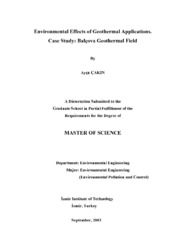Please use this identifier to cite or link to this item:
https://hdl.handle.net/11147/3770| Title: | Environmental effects of geothermal applications case study: Balçova geothermal field | Authors: | Çakın, Ayça | Advisors: | Gökçen Akkurt, Gülden | Publisher: | Izmir Institute of Technology | Abstract: | Direct application of geothermal energy can involve a wide variety of end uses, such asspace heating and cooling, industrial applications, greenhouses, fish farming, and health spas. It uses mostly existing technology and straightforward engineering. The technology, reliability, economics and environmental acceptability of direct use applications of geothermal energy have been demonstrated throughout the world.The use of geothermal energy is the minimum waste forming type of energy in the world. Geothermal energy is also considered cheap, sustainable and environmentally friendly when compared to the other energy resources.Turkey has abundant geothermal resources because of its location. In particular, İzmir-Balçova district heating system is one example of the high temperature district heating applications in Turkey exhibiting high geothermal potential.The objective of the Thesis is threefold, namely: (a) to determine the negative and positive environmental effects of Balçova Geothermal District Heating System, (b) to find out sources of contamination if pollution exists (c) to offer a solution to protect the public health.Contamination may occur in Balçova Geothermal Field in either water phase or soil phase. Therefore, a sampling program was developed in order to monitor the alterations in water. The sampling points were chosen in a way that Balçova District Heating System production wells, groundwater wells, and the irrigation points could all be monitored.In order to investigate the contamination of the region, several parameters including physical properties such as temperature, electrical conductivity, total dissolved solids, alkalinity; non-metallic constituents such as ammonia, boron, chloride, silica, sulfate; and metals and semi metals such as calcium, magnesium, sodium, potassium etc. were determined.The results of this study showed that all of the samples had bicarbonate alkalinity. The concentrations of the parameters were not constant during the monitoring study. This may be because of the nature of geothermal fluid. During the studying period, concentrations of many heavy metals were below the limit of detection of atomic spectrometric techniques used in the study. Wells T and I did not seem to be suitable for drinking and irrigation water, respectively.In order to determine the effects of Balçova District Heating System on physical environment, noise measurements were conducted. The results of noise measurements have shown higher values than the acceptable limits of Noise Control Regulation. | Description: | Thesis (Master)--Izmir Institute of Technology, Environmental Engineering, Izmir, 2003 Includes bibliographical references (leaves: 94-97) Text in English; Abstract: Turkish and English xv, 97 leaves |
URI: | http://hdl.handle.net/11147/3770 |
| Appears in Collections: | Master Degree / Yüksek Lisans Tezleri Sürdürülebilir Yeşil Kampüs Koleksiyonu / Sustainable Green Campus Collection |
Files in This Item:
| File | Description | Size | Format | |
|---|---|---|---|---|
| T000300.pdf | MasterThesis | 1.14 MB | Adobe PDF |  View/Open |
CORE Recommender
Page view(s)
230
checked on Nov 18, 2024
Download(s)
128
checked on Nov 18, 2024
Google ScholarTM
Check
Items in GCRIS Repository are protected by copyright, with all rights reserved, unless otherwise indicated.